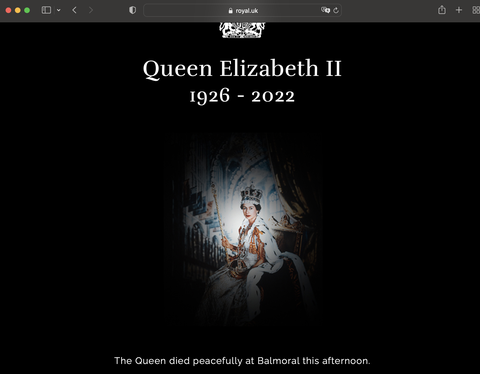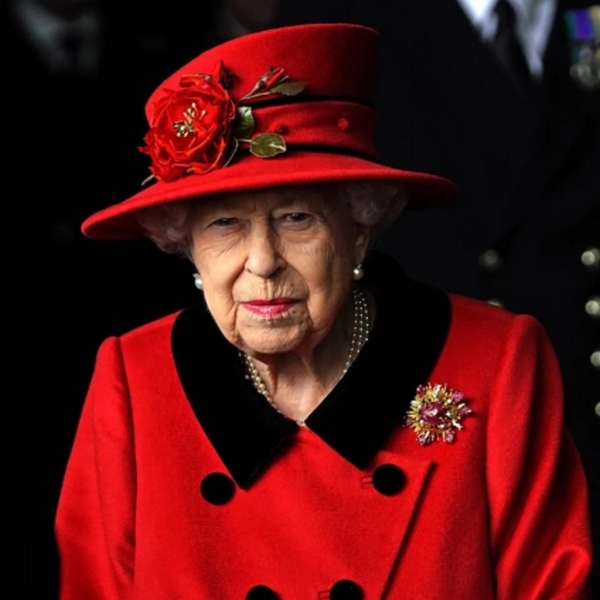On the afternoon of September 8, Queen Elizabeth II passed away peacefully in Balmoral, the Palace announced.
The Queen served as the U.K.’s reigning monarch for 70 years, making her the second-longest serving sovereign in history. With decades of service behind her, it’s hard to imagine the monarchy without her at the helm. But “The Firm”—as the royal institution in Britain is dubbed—has a plan for when the Queen passes, along with a set line of succession for who takes the throne next.
Here, what happens next. The Queen’s immediate family (including new King Charles) is in Balmoral with her, where she was under medical supervision earlier today.
What happens when the Queen dies?
Politico reported full details of Operation London Bridge, the code name for the U.K. government’s plan for when the Queen passes, in September 2021. (Operation London Bridge is triggered if she dies in London, while Operation Union is in place if she dies in Scotland.) There will be 10 days of activity from the Queen’s death to her funeral.
Immediately after:
Prime Minister Liz Truss, who was just received by the Queen earlier this week, and her Cabinet will meet the Queen’s coffin at St. Pancras station. Prince Charles, who is first in line to the throne and at that point King, will tour the U.K. in the day before the Queen’s funeral.
Immediately following the Queen’s death (that day is referred to as “D-Day”), the prime minister will be informed by the Queen’s private secretary. A number of the most senior ministers and officials will also be informed before the general public is told via an “official notification” from the Palace.
Ceremonially, flags across Whitehall will be lowered to half mast. The royal family’s website will change to a black holding page with the statement announcing the Queen’s passing. That has already happened, right as the family announced the news:

The Royal Family’s website following the Queen’s passingROYALS.UK
The royal family will announce plans for her funeral, which, per Politico, is expected to be held 10 days after her death.
Prince Charles, now King, will deliver a broadcast to the U.K. that evening at 6 p.m. local time. A service of remembrance will also take place at St. Paul’s Cathedral that night.
The first day following:
Charles will be proclaimed as the new sovereign. Parliamentary business in the U.K. will be suspended for 10 days.
The second day following:
The Prime Minister will meet the Queen’s coffin. If the Queen passes away at Balmoral, “Operation Union” will be enacted, per Politico, meaning her body will travel to London by royal train if possible. If that is not possible, “Operation Overstudy” will take place instead, and her coffin will travel by plane instead.
The third and fourth day following:
King Charles will start his tour of the United Kingdom.
On the fourth day, a rehearsal for the procession of the Queen’s coffin from Buckingham Palace to the Palace of Westminster will take place.
The fifth day following:
The procession of the Queen’s coffin from Buckingham Palace to the Palace of Westminster will happen, ending with a service in Westminster Hall.
The sixth day to the day of the funeral:
The Queen’s coffin will remain in the Palace of Westminster for three days, where the public will be able to visit and pay their respects.
On Day 6, the state funeral procession rehearsal will take place.
Other heads of state and VIP from abroad will arrive for the funeral. The day of the funeral, per Politico, will be a “Day of National Mourning,” something the prime minister and Queen agreed to beforehand. The day will be treated like a bank holiday, but if it falls on an existing bank holiday or weekend, no extra day will be given off. Employers will not be ordered to give their employees a day off.
On the day of the funeral:
The funeral will be held at Westminster Abbey, with a two-minute silence across the U.K. being planned at midday. A committal service will be held in St. George’s Chapel at Windsor Castle, with the Queen ultimately being buried in the castle’s King George VI Memorial Chapel.
How old is the Queen and how long has she reigned?
Born on April 21, 1926, the Queen is 96 years old. She ascended the throne in February 1952 and has ruled for 70 years, making her the longest reigning monarch in British history. (She surpassed a record previously held by Queen Victoria.) She is also the second-longest reigning monarch in world history, currently second to King Louis XIV of France, who ruled for over 72 years before he died in 1715.
Who are the Queen’s children and grandchildren?
The Queen has four children, whom she shares with her late husband Prince Philip. From oldest to youngest, they are: Prince Charles, Princess Anne, Prince Andrew, and Prince Edward.
She has eight grandchildren: Peter Phillips, Zara Tindall, Prince William, Prince Harry, Princess Beatrice, Princess Eugenie, Lady Louise Windsor, and James, Viscount Severn.
She also has 12 great-grandchildren: Savannah Phillips, Isla Phillips, Prince George, Mia Tindall, Princess Charlotte, Prince Louis, Lena Tindall, Archie Harrison Mountbatten-Windsor, August Philip Hawke Brooksbank, Lucas Philip Tindall, Lilibet “Lili” Diana Mountbatten-Windsor, and Sienna Elizabeth Mapelli Mozzi.
Who’s next in line for the throne?
Prince Charles will ascend to the crown when his mother Queen Elizabeth II passes. Here’s what the line of succession for the throne will be once Charles becomes king, according to the royal family’s site.
Prince Charles (King)
- Prince William (Charles’ first child)
- Prince George (William and Kate Middleton’s first child)
- Princess Charlotte (William and Kate’s second child)
- Prince Louis (William and Kate’s third child)
- Prince Harry (William’s brother and Charles’ second child)
- Archie Mountbatten-Windsor (Harry and Meghan Markle’s eldest child)
- Lilibet Mountbatten-Windsor (Harry and Meghan Markle’s youngest child)
- Prince Andrew (Charles’ younger brother and the Queen’s third child)
- Princess Beatrice (Prince Andrew’s eldest child)
- Sienna Mapelli Mozzi (Princess Beatrice’s first child)
- Princess Eugenie (Prince Andrew’s second child)
- August Brooksbank (Princess Eugenie’s first child)
- Prince Edward (Charles’ youngest brother and the Queen’s fourth child)
- James, Viscount Severn (Prince Edward’s second child)
- Lady Louise Mountbatten-Windsor (Prince Edward’s first child)
- Princess Anne (Charles’ younger sister and the Queen’s second child)
- Peter Phillips (Princess Anne’s first child)
- Savannah Phillips (Peter Phillip’s oldest child)
- Isla Phillips (Peter Phillip’s second child)
- Zara Tindall (Princess Anne’s second child)
- Mia Tindall (Zara Tindall’s oldest child)
- Lena Tindall (Zara Tindall’s second child)
- Lucas Tindall (Zara Tindall’s third child)
The Succession to the Crown Act, which took effect in 2015, states that the gender of a royal born after October 28, 2011 doesn’t give that person or their descendants precedence over anyone else in the line of succession. Before this, women were passed over by their younger male siblings in line for the throne, such as Princess Anne and Lady Louise, shown above. When Princess Charlotte’s younger brother, Prince Louis, was born in 2018, she was not bumped down in the order of succession.

